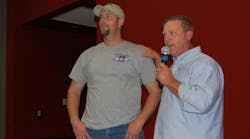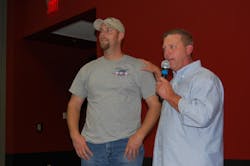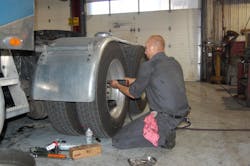[Swann, seen in photo at right in the baseball cap, is in the running again this year, having made it to the final round in the Eaton transmission category.]
A 16 year veteran RTC technician working out of the company’s Dallas, TX, facility, Swann offers some interesting perspective on the maintenance challenges posed by today’s commercial trucks, which are packed with computers controlling almost every facet of their operation.
“Things are very different now than when I started; now it is all about using computers to diagnose and often fix problems, not so much turning wrenches anymore,” he explained.
Yet that also means a technician has to learn to be his very own “computer geek” as well, often needed to know how to fix computer errors and electronic tool glitches in the process.
“For example, during my test [at the Rodeo competition] the computer froze up, so we had to reboot it. That happens a lot more often than you would think in the shop, too, so it’s something technicians need to learn to handle,” Swann said.
Another time, a diagnostic tool with low battery power gave him a false reading that sent him “down the rabbit hole” trying to fox a fault that actually wasn’t there.
Swann added that due to all the electronics packed on today’s trucks, some unusual errors can result, requiring more out-of-the-box thinking on the part of technicians than many realize is needed.
“It’s not always ‘follow step one, two and three’ on the [diagnostic repair tree] and the fault is fixed,” he explained. “Sometimes you shouldn’t even be at step three because that is leading you the wrong way; you don’t want to go down the rabbit hole with a repair.”
Swann described a situation where such “critical thinking” solved a particularly stubborn maintenance issue.
“I had this situation once where I had three trucks with ABS [antilock braking system] faults,” he told me. “I had an engineer from the [brake system] supplier with me, and after a full day working on them, we still could not fix them.”So Swann stepped back and looked at the big picture one more time … and found the source of the fault.
“The problem wasn’t in the [brake] system and it wasn’t on the truck,” he explained. The fleet in question offered its drivers a bonus on fuel economy and idle reduction fuel savings. As a consequence, drivers turned on and turned off their vehicles frequently – even if they had to only move them two feet.
What Swann discovered is that the frequent and fast ignition cycles didn’t allow the ABS to run a full system check – and thus triggered all sorts of fault codes as a result.
“It didn’t allow the ABS to fully cycle, so all the drivers needed to do was allow it to fully cycle before shutting the truck off,” he noted. “That would stop triggering all the ABS warning lights.”
Swann added that this is a situation engineers in the laboratory designing such technology probably never even experienced as, of course, almost by instinct let the system fully cycle.
“Out here in the real world very different things happen,” he explained, noting that technicians are often like “front-line infantry” in the truck repair world in terms of the time pressures and unusual situations they face.
“An engineer in a lab, he can experiment with different things, swap out components, and have time to do all of that,” Swann said. “In my world on the shop floor, time is critical and the customer must approve of every component you replace – so if a solution you thought would work doesn’t work, that can make things even more difficult.”





